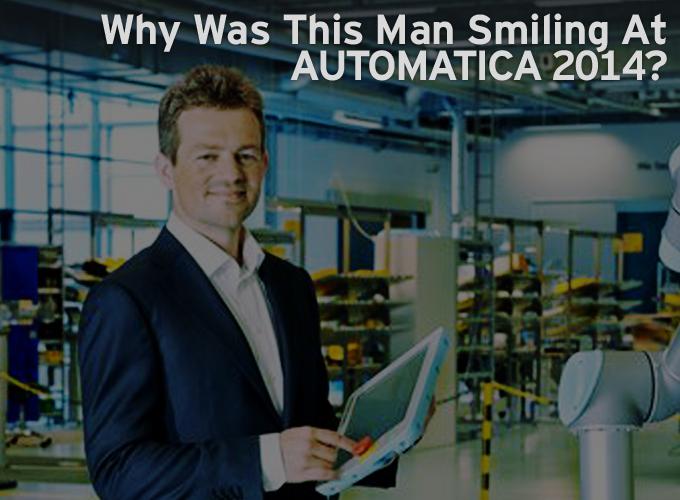At this AUTOMATICA the hype theme was definitely collaborative robotics -- our robots can work alongside your human workers safely.
Frank Tobe
34,500 visitors from more than 100 countries came to Munich this June to visit AUTOMATICA 2014 and examine the robotics-related wares of 731 exhibitors from over 42 countries.

But why was Esben Østergaard, CTO of Danish Universal Robots smiling? Perhaps it was because his company was one of the showpieces of AUTOMATICA’s focus this year on Service Robots? Or that the software and programming tablet he’s holding were of the caliber that causes disruption in the industry?
Teaching a robot to do the jobs robots do requires two kinds of software: an operating system under which programs run, and a method of entering programs describing what needs to be done. The major robot manufacturers use proprietary software and teach pendants for those two tasks. Their operating software, because it is old, requires legacy software engineering talent which is hard to find these days because most young people coming out of tech and grad schools have spent their college years using ROS or similar open source robotic operating systems. ROS, particularly ROS-Industrial, is a comprehensive system with libraries that cover and enable programming and simulating all the devices that are likely to be added onto a robot system such as different types of grippers, vision systems, sensors, etc.
 Universal Robots reinvented the teach pendant to be tablet-based, simple to operate, and intuitive to use. Since UR only has one product in two sizes, their UR Control software and PolyScope tablet system don’t have to provide all the bells and whistles programmed into older style robots.
Universal Robots reinvented the teach pendant to be tablet-based, simple to operate, and intuitive to use. Since UR only has one product in two sizes, their UR Control software and PolyScope tablet system don’t have to provide all the bells and whistles programmed into older style robots.
"Our base product is simple to program for simple applications. I think this is how you get the maximum productivity out of our robots, that is, by making sure that the projects are kept simple. However, we do see lots of highly complex applications with our robots too, and that is also interesting. So our robots can do both," said UR's Østergaard.
Universal is not the only company providing new methods of instructing a robot to do their set of tasks. But they’ve been in the marketplace for the last four years and have 3,000 robots at work in over 50 countries around the world. Thus they have a lot of experience with users using their software and tablets, and are far ahead of any competitor at this time.
“There’s no PC-based language for the Universal Robot system,” said Ed Mullen, UR USA Sales Manager, in a recent interview by Tanya Anandan for the Robotic Industries Association. “By pressing buttons on the tablet, you can jog each individual axis to make the robot go into position. Or you can press a button on the back of the teach tablet that back-drives all the servomotors. Then you can physically grab the robot by its wrist and move it into position, and it will learn that point. You don’t have to be a degreed engineer to interface with this robot,” adds Mullen. “Anybody can be trained to use this robot in 15 minutes.”
KUKA, ABB and Yaskawa Motoman
 KUKA promoted their new lightweight arm, LBR iiwa, in a separate very large booth with brochure copy saying the LBR “feels you, is sensitive, flexible and safe.” Nevertheless, the same teach pendant that KUKA has used for years is used for the new robot although they have added a teach-by-demo capability. Their LBR robot is well designed and appears to function alongside humans - but their cost is 3 times that of Universal Robot’s. Yaskawa Motoman’s Dexter Bot fits into this category of six-figure 7-axis arms safe to work alongside. The benefit KUKA and Yaskawa offer over start-ups Rethink Robotics and Universal Robots is speed and precision; their downside is the same old software and teaching methods, high cost and higher cost of installation and training. ABB’s FRIDA, a stylish 2-armed robot, was shown doing an inane task alongside a human worker, a young woman. There was no interaction between the two - the robot snapped two pieces together and placed the result in front of the girl and she picked it up and added another piece and placed the finished component in a tray. I felt sorry for her. It was an unreal and unflattering situation. ABB’s FRIDA isn’t offered for sale just yet although it has been many years in testing and demos.
KUKA promoted their new lightweight arm, LBR iiwa, in a separate very large booth with brochure copy saying the LBR “feels you, is sensitive, flexible and safe.” Nevertheless, the same teach pendant that KUKA has used for years is used for the new robot although they have added a teach-by-demo capability. Their LBR robot is well designed and appears to function alongside humans - but their cost is 3 times that of Universal Robot’s. Yaskawa Motoman’s Dexter Bot fits into this category of six-figure 7-axis arms safe to work alongside. The benefit KUKA and Yaskawa offer over start-ups Rethink Robotics and Universal Robots is speed and precision; their downside is the same old software and teaching methods, high cost and higher cost of installation and training. ABB’s FRIDA, a stylish 2-armed robot, was shown doing an inane task alongside a human worker, a young woman. There was no interaction between the two - the robot snapped two pieces together and placed the result in front of the girl and she picked it up and added another piece and placed the finished component in a tray. I felt sorry for her. It was an unreal and unflattering situation. ABB’s FRIDA isn’t offered for sale just yet although it has been many years in testing and demos.

gomTec
A new company, gomTec, displayed their new lightweight arm named Roberta in a spectacular booth. They had an army of Roberta's on display (and a salesperson for each robot) but no software or teaching method. That was coming they said. Their price point and funding were all in place to compete with Universal. A spinoff from the DLR’s Institute for Robotics and Mechatronics with a history dating from 2005, gomTec already has a significant marketing arm into the automotive industry for their other products and has funding to pursue an aggressive marketing plan later this year when Roberta is ready for sale.
SMErobotics and the Fraunhofer Institute
SMErobotics, the EU public-private-partnership to provide robotic solutions for small and medium-sized enterprises, has defined the need for software improvements such as those achieved by Rethink Robotics and Universal Robots and suggested that it was time to incorporate “smart” and “intuitive” technologies into the robot programming process. The big pitch that SMErobotics makes is that the robot must be plug and play AND easy to program AND safe. The thesis is that the SME will know what needs to be done and won’t need an integrator to help them set it up and get it running.
SMErobotics had a booth at AUTOMATICA and, along with the Fraunhofer IPA, displayed their work-in-process toward such a new training and robot instruction methodology. It was a slick presentation and very comprehensive. SMErobotics’ approach is to provide software components that help plan what is needed — it determines and develops the necessary robot sequences and grasp methods either from CAD data or from physical training of the robot — and then generates and graphically displays robot programs to implement those motions and sequences. The software incorporated many new innovations: a tablet interface; sensors and the robot instructed from the same interface; the PC-based control system works on any robot and sensor setup; and the system learns normal robot behavior and detects unexpected deviations. But as slick as it was, it was still on the drawing board and not yet being deployed in the field. Nevertheless, the video they produced is very descriptive, informative and worth watching.
Conclusion
Buzz to me is excitement and activity. At AUTOMATICA, I measured the buzz by the size and noise of the crowd around a booth. Festo is a global supplier of pneumatic and electrical automation technology with a flair for advertising their wares through the use of glitzy and attention-getting animal robots (elephant, kangaroo, seagull, etc.). Their booth was always crowded and noisy. KUKA’s LBR iiwa and gomTec’s Roberta booths also had big crowds. As did the Universal Robots booth.

Trade shows such as AUTOMATICA often offer hype instead of substance for new products. At this AUTOMATICA the hype theme was definitely collaborative robotics -- our robots can work alongside your human workers safely.
A hyped-up press release from AUTOMATICA proclaimed:
“Robotics and automation are reaching a new dimension with man-machine cooperation. Robots are handling work in the place of people that is monotonous, injurious to health and requires no special job skills. This makes workplaces more productive, flexible and ergonomic. AUTOMATICA also showed the enormous potential for small- and medium-sized firms in numerous examples.”
In the Stäubli booth they were playing a video showing a child interacting with a robot and saying that their robots worked with speed, precision, safety... and with man.

To both I’d say, “Not yet - but soon.” Universal Robots and Rethink Robotics are quietly leading the way into a marketplace that is breaking down the cages that have surrounded robots for 50 years. Rethink Robotics' Rodney Brooks has defined the need and helped users understand what can be done. And he has inspired customer demand for this type of collaborative robot. Human-robot interaction is happening for sure; but not at the pace the hype suggests.
The content & opinions in this article are the author’s and do not necessarily represent the views of RoboticsTomorrow
Comments (0)
This post does not have any comments. Be the first to leave a comment below.
Featured Product


